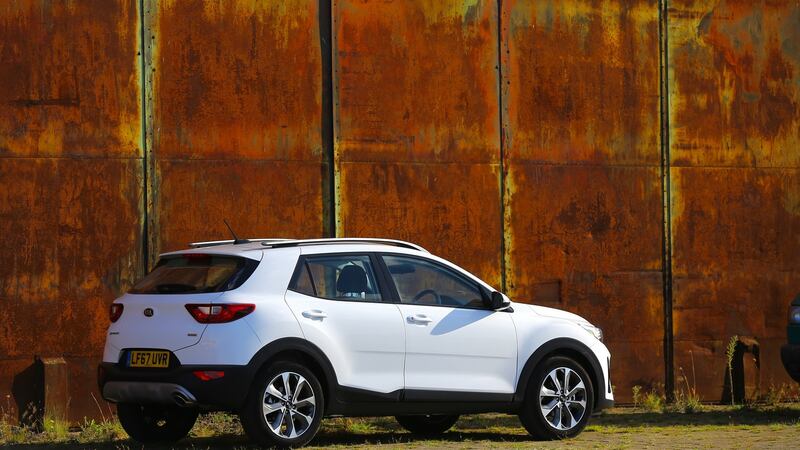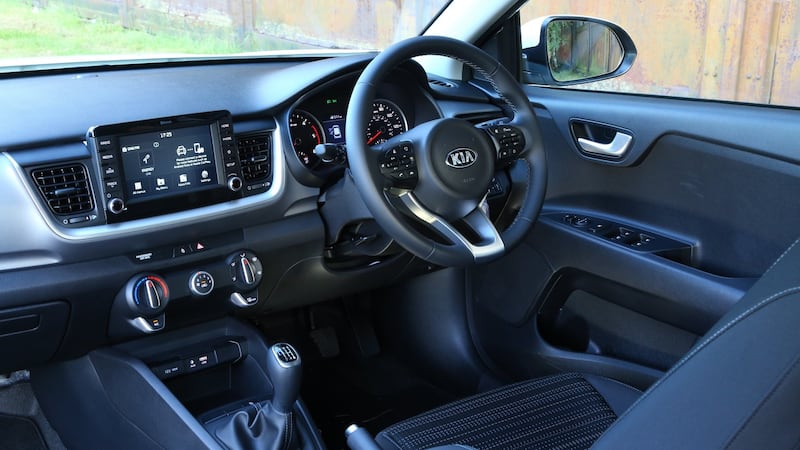To say that sales of compact crossovers are booming would be an insult to dynamite. The mad, headlong rush by we, the buying public, for cars that impersonate rugged 4x4s has driven the market way past boom status and into full on Big-Bang-expansion. Fully one fifth of every car currently sold in Europe is a small SUV, and that number is only growing.
Kia awards itself some credit for this rocket-ship upward curve, claiming that the original Kia Soul helped to convince buyers that a small faux-by-four could be an enticing purchase. There may be some truth in that, but since then the Korean carmaker has lost out.
The Soul, though likeable, was primarily designed for the American market and has never sold well in Ireland. So here comes the Stonic (a portmanteau of Speedy and Tonic and if you can work out why, please write in…) to turn around Kia's sales in this fast-growing segment of the market.

King of the segment is currently the Renault Captur, which has shifted some 1,800 sales so far this year, almost all diesel. Kia’s plan for the Stonic in Ireland is necessarily slightly more modest – about 1,000 sales in a full year – and focused on petrol sales.
The 1.4-litre 100hp petrol is expected to be the best-selling model, with the 110hp 1.6-litre CRDI diesel relegated to also-ran status. Prices start from a tempting €18,599 for the entry-level model, but that’s a deceptive number. Kia admits that this is a price-point special, bereft of niceties such as air conditioning or roof-rails, and running a weedy 1.2-litre 85hp petrol engine.
The real meat of the Stonic range lies in the “K2” spec models, using the 1.4-litre engine, and those start at a slightly more robust €21,099. Which raises the slightly awkward question – are you prepared to pay Cee’d money for what is, essentially, a Rio with shin extensions?
For that is what the Stonic, mechanically speaking, is. It rides on the same platform as the Rio supermini, and borrows its engines and interior all but wholesale. Therein lies the flaw at the heart of any small crossover proposal; you’re basically buying a hopped-up small car at a premium price.
Many are, clearly, happy to do so, and the primary reason for their purchase (assuming faith in the marketing research) is style. It’s the only segment of the market (again, faith assumed) where exterior styling holds primacy over the purchase decision, and in fairness the Stonic is in possession of a strong hand here. It looks really sharp, using a deeper version of the Kia “Tiger” grille, and a neat design element whereby the rear pillar of the car appears to loop over the top of the roof, almost like a race car’s roll-over bar.
You can have bright yellow paint if you like (metallic grey or simple red looks better though) and there is even a contrasting roof option, in black, white, grey, red, or even lime green.
Kia is aiming this car at trendy, urbanista hipsters (isn’t everyone, these days?) and so the car is set up for inner city combat. It looks suitably chunky and square-edged, and from the driver’s seat, it’s easy to point and aim the car through narrow gaps in the traffic. The steering is light, doesn’t tell you much about what the front wheels are doing, but aims the blunt nose with accuracy and no small sense of agility.

It does feel a touch firm and springy, though, in spite of Citroen-style hydraulic bump stops for the suspension. Berlin (the location for the launch event) has relatively smooth city streets, so we'll have to see how the Stonic copes with Irish-spec tarmac.
The 1.4-litre MPI petrol engine performs well enough, for what is quite an aged design at this point. 100hp is a reasonable power output, and it’s smoother than a diesel (albeit too shouty at high revs) but there’s a big flat-spot in the middle gears at lower engine speeds, where those of us now used to a turbo will find much frustration. Emissions are not too bad, at 125g/km (€270 a year to tax) but the star engine – the 1.0-litre T-GDI 120hp turbo petrol three-cylinder unit – is the most expensive one. This little engine buzzes and fizzes with personality, and lifts the whole driving experience with its feeling of vim. Plus it’s only 6g/km worse in the Co2 stakes (115g/km versus 109g/km) than the small-selling diesel model.
But while the Stonic is handsome on the outside and not disgraced in dynamic terms, it is a bit of a let-down inside. The cabin flatters to deceive, with a pleasingly chunky countenance (helped by the optional application of contrast colour trims) and the good-looking, easy to use seven-inch touchscreen is standard on all models. Plus the front seats are good and the driving position sensibly arranged.
The problem is at a material level. The plastics used have been stuck together well, but they are all cheap and nasty to the touch. Everything feels tinny and there’s a sensation that the whole cabin could well be a rattle trap in the future. That’s the sadly low-set bar for the class, though.
Rear seat space is Okay, but the boot, at 352 litres, is just too tight for family car duties. Again, that’s par the course for small SUVs, and more’s the pity.
The Stonic is essentially likeable and it pushes, without effort, all of the buttons to make it all but a sure-fire success in the B-SUV segment. But it’s aiming at a low bar, in terms of dynamics and practicality, and that just rankles. As does the fact that, if you’re a family buyer, a similarly-priced Cee’d hatchback or estate is a far, far better car.
The lowdown: Kia Stonic 1.4 MPI K2.
Price: €21,099 as tested; Stonic range starts at €18,599.
Power: 100hp.
Torque: 133Nm.
0-100km/h: 12.6sec.
Top speed: 172km/h.
Claimed economy: 51.3mpg (5.5 litres/100km).
CO2 emissions: 125g/km.
Motor tax: €270.
Verdict: By the standards of the class, the Stonic is a winner. By any other standard, it's firmly middle-ground.
Our rating: 3/5











